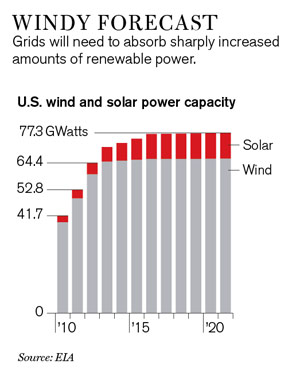Managing Renewables
Creating smart grids will require new technologies along the entire chain of electricity generation, distribution, and consumption. These systems will let operators know exactly how electricity is flowing through the grid from moment to moment, and they will make it possible to control that flow quickly and precisely.

At the heart of smart grids is communication. Grid operators are moving toward Internet-based protocols that can rapidly exchange information between many locations. Faster communication is crucial for one of the most important new technologies: units that measure, many times per second, the waveform of the alternating current flowing through the line. Changing waveforms can alert operators to problems on the grid; the information is relayed back to centralized control units and then to utilities. This technology represents a huge step forward from the old system, in which it’s not unusual for a utility to be unaware of a transmission problem until a customer calls to complain that the power is out.

Control over the grid has also been improved by new and upgraded supervisory control centers and data acquisition centers. These centers have relied on the telephone network to communicate with substations, but new systems use Ethernet-based networks or other modern technologies. Information gathered from all over a local transmission network makes it possible to respond to problems—a downed power line or a lightning strike—within fractions of a second.
Being able to control the flow of electricity in close to real time is essential if unpredictable energy sources, such as solar and wind, are to provide a significant fraction of our electricity. Left unchecked, a sudden variation in power output from, say, a wind farm could destabilize a grid. Today, grids can absorb such fluctuations because wind is responsible for only a small amount of power—about 2 percent of electricity generated in the United States. But once wind power accounts for a significant percentage of electricity, we’ll need a better way to manage the grid.
Besides large-scale energy storage technologies (see “Better Storage”), another thing that could makes renewable sources more manageable is an existing technology called flexible AC transmission systems, or FACTS. These systems generally use semiconductor components specifically designed to handle high voltage and current in a way that stabilizes power flow. They can be added to substations or set up as stand-alone units where a wind or solar installation connects to the grid.
Keep Reading
Most Popular
Large language models can do jaw-dropping things. But nobody knows exactly why.
And that's a problem. Figuring it out is one of the biggest scientific puzzles of our time and a crucial step towards controlling more powerful future models.
How scientists traced a mysterious covid case back to six toilets
When wastewater surveillance turns into a hunt for a single infected individual, the ethics get tricky.
The problem with plug-in hybrids? Their drivers.
Plug-in hybrids are often sold as a transition to EVs, but new data from Europe shows we’re still underestimating the emissions they produce.
Google DeepMind’s new generative model makes Super Mario–like games from scratch
Genie learns how to control games by watching hours and hours of video. It could help train next-gen robots too.
Stay connected
Get the latest updates from
MIT Technology Review
Discover special offers, top stories, upcoming events, and more.